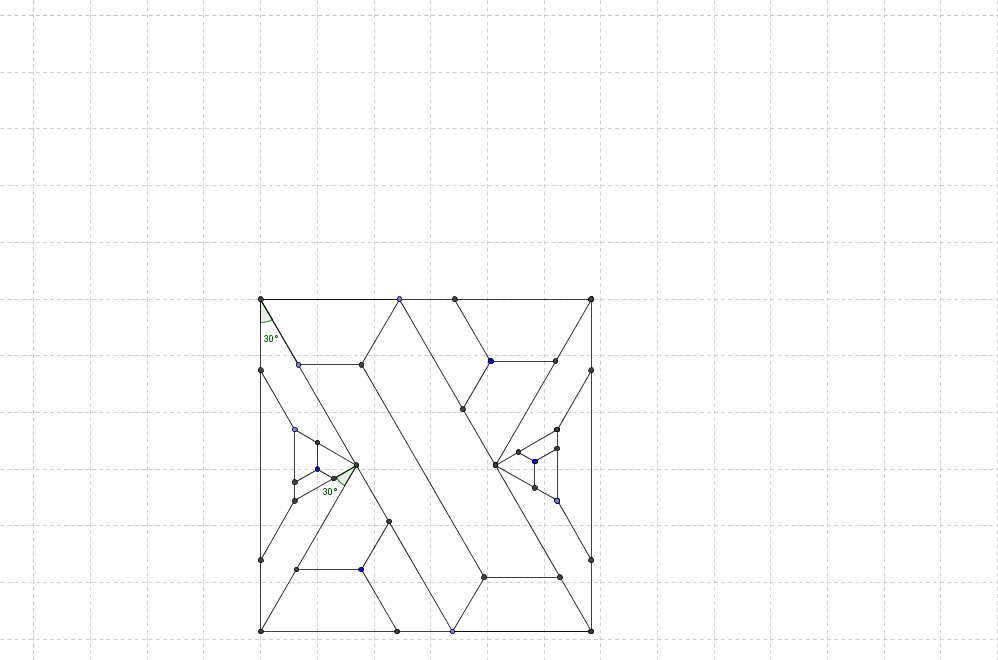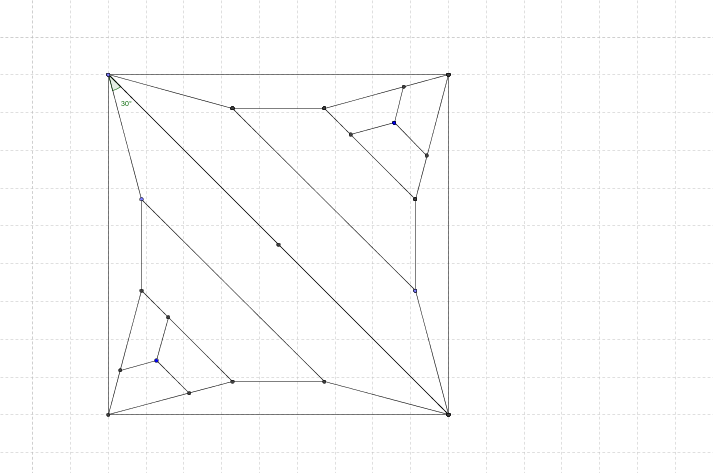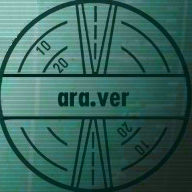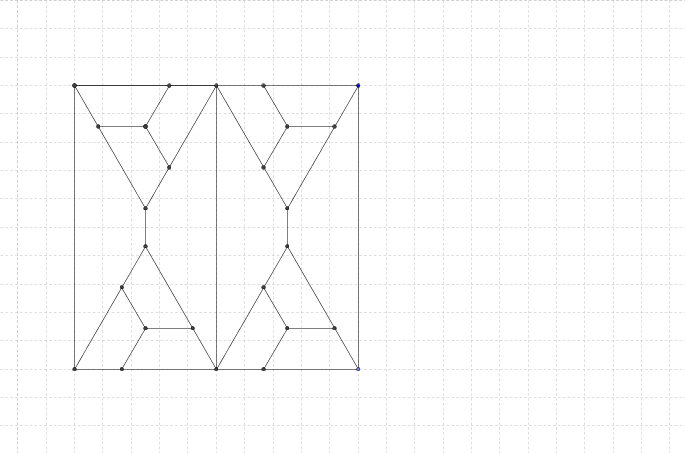-
Posts
1976 -
Joined
-
Last visited
-
Days Won
5
Content Type
Profiles
Forums
Events
Gallery
Blogs
Posts posted by araver
-
-
Ah ha!
of using both binary and hex!
Nice work.
thought of it straightforwardly

... although after discovering the middle letters's algorithm and observing the hex patterns I suspected it:
- It was obvious from the impressive amount of command/pairs that each letter counts (from the first 4 letters and last 4 letters at least) especially observing 4 letter-states and North/South pairs.
- I had a hunch that each letter counts observing that small variations in input may affect one or even 2 hex digits (kinda differential if I come to think about it).
- It was logical that a function with 4 arguments outputting a single hex character has to account somehow for the only 16 combinations while being simple enough. Assigning each of the arguments a {0,1} output and recombining them to form a binary is just the most natural way to do this.
- Saw the exact pattern(s) only after storing the 4 letters from the command and the corresponding 3 digit hex number in excel and sorted in ascendant order by each of the hex digits.
The hash algorithm could have been even more difficult to crack without an increase of difficulty for the person using it:
OBS1 - using a pre-established fixed permutation in forming the binary (obscures a little the functions, the vowel function was very easy to spot!)
OBS2 - use letters that do not actually affect the output (which could be a killer to crack if only a small number of command/password pairs are known).
Anyway, it was a very nice challenge. I'd rate it as moderately tough because of the two possible obscurity reasons above (it actually has only one layer of obscurity if I may say so).
Thanks octopuppy for the challenge.
-
Araver, I thought for awhile there must be two correct answers... but I finally figured out why yours can't be correct... your 9th witness has an interesting name for a man.
 Forgot about that clue.
Forgot about that clue. -
First character of password
----------------------------
Take first 4 letters of command.
Write 1 if they are vowels or 0 if non-vowels. E.g. ABCE is 1001.
Write this binary number (written from left to right) as hex. E.g. ABEE=1011=1*4+0*2+1*1+1=6.
This hex character (since 1111=F is maximum) is the first character of the password.
Second character of password
----------------------------
Take first 4 letters of command.
Write 1 if they are after M in the alphabet (N,O,P,Q,etc) and 0 otherwise (A,B,C...M).
Again interpret the binary number as a hex. E.g. AMEQ = 0001=1
Third character of password
---------------------------
Take first 4 letters of command.
Write 1 if they are closed-curves(which contain a closed figure such as a circle or triangle: A,B,D,O,P,Q,R)
and 0 otherwise.
Again interpret the binary number as a hex. E.g. ABOD = 1111=F AEQF=1010, etc.
Fourth character of password
----------------------------
Equal to the fourth letter of command
Fifth character of password
---------------------------
Equal to the fourth letter of command counting from right-to-left.
Sixth character of password
---------------------------
Same algorithm as the first character, applied to last four letters of command.
Seventh character of password
---------------------------
Same algorithm as the second character, applied to last four letters of command.
Eighth character of password
---------------------------
Same algorithm as the third character, applied to last four letters of command.
-
A3FRB47E
I know spoilers are not *necessarily* needed, but still want to use them. Awesome game, wouldn't want others to miss the fun.
-
Order..........First Name..Last Name..Occupation
1st Witness....Mark........Thompson...BankTeller
2nd Witness....Kathy.......Anderson...Dentist
3rd Witness....Betty.......Zimmer.....Programmer
4th Witness....Glenn.......Ducklow....Mechanic
5th Witness....Mary........Olson......Accountant
6th Witness....Frank.......Miller.....Secretary
7th Witness....Sandra......McNeil.....Teacher
8th Witness....Diane.......Fuller.....Pilot
9th Witness....Anne........Simpson....Musician
10th Witness...John........Williams...Author
-
Question about something over which a few rules are still unclear: The statement "Then his target marking will be the numbers" is unclear and also examples are not clarifying the following situation:
A shooter targets an opponent and shoots him until his opponent dies/flees OR does he change the target according to the target&aim algorithm every time it has a trigger action, even if his target is not down?
E.g.
team 1: G(1)G(2)
team 2: R
The Red in team 2 fires on the first G until he dies or does he aim in second 1 at G(1) and second 2 at G(2)?
Let NB, NG, NR be the Number of Blue, Green and Red shooters.
From 1. Leaders are Red -> NR>=2 (at least one R for each clan)
From 3. Earp clan has 4 Greens -> NG>=4 (maybe Jessie clan has greens, maybe not)
From 2. There are as many Blues as others -> NB=NG+NR. With the other clues this gives NB>=6.
From Factor 3. (how the guns are loaded) updating the shooting patterns with the empty slots :
123456789
G 10M010M010MR
B 1M001M001MRR
R 1M1000M1MRRR
where R=Reload (as in OP) and M=miss (as the gun had an empty slot, the shooter actually misses ... without actually firing or making a sound)
Assuming from factor 2 that all are given additional bullets enough to fully load once and this time the loading isn't rigged by IDoILike, the next 12 rounds follow the original shooting patterns for those left standing.
From the fact that 14 shots were heard in first 3 seconds and from the updated shooting patterns in the first 3 seconds (excluding misses as not making actual firing noises)
G 10M
B 1M0
R 1M1
we get NB+NG+NR+LR=14 where LR = number of Reds Left standing after 2 seconds that get to fire in the third second.
Clearly LR<=NR. Assume at least one red flees/dies in the first 2 seconds (LR<NR). Since there is no firing in the second second (pardon the pun
 ) he must flee after the first second, so he must sustain at least 6HP damage in the first second which means at least 6 different shooters targeting him.
) he must flee after the first second, so he must sustain at least 6HP damage in the first second which means at least 6 different shooters targeting him. In the first second, since Jessie clan has at least one Blue, all Earp's Greens are busy shooting Jessie's Blues and Earp's Red(s) are busy shooting either Jessie Greens or if they don't find one, Jessie Blues (we know there's at least one). This only leaves Earp's Blues to target Jessie Reds.
Therefore the Jessie Red(s) would have to suffer at least 6 shots from Earp's Blues in the first second to flee/die.
In that case, there are at least 6 Earp Blues + at least 7 Jessie Blues (Fact 4. Jessie clan has the most Blues). That means at least 19 shots in the first second (13 blues + 4 greens + 2 reds). Impossible.
So at least Jessie's Red Leader survives (along with other Jessie Reds if any) or equivalently LR >=1.
Therefore NB=14-NG-NR-LR<=14-4-2-1=7.
So NB=7 or NB=6. Note that NB=7 implies LR=1 NR=2 NG=4 which contradicts the fact that there are as many Blues(7) as others(6).
So NB=6, which implies LR=NR=2, NG=4.
While the Red and Green distribution between the clans is clear, the 6 Blues can be distributed between Earp and Jessie clans in two ways (1,5) and (2,4):
- because Jessie clan has the most Blues
- and Earp clan actually wins by one Blue so it has at least one lucky Blue.
So the battle is either:
(Battle 1) RBGGGG vs BBBBBR
(Battle 2) RBBGGGG vs BBBBR
Simulation of these battles, according to either variation of the target&aim rule (see my previous question) don't give the expected result "Earp clan won by 1 Blue standing."
-
Hint: [2] is not a "base" relationship; it's a rather ad hoc equivalence included to make a set of three.
1031=97*10+61
1225=97*12+61
so they're equal modulo 97 and also share an interesting property - their quotients are the first two digits concatenated.
Am I getting too far here?

-
and if the answer is recorded and he has only to press the button(either white or black )!!!
moreover ..singing is a kind of hint...
the prisoners should think of bribing whoever's in charge of the dots to manipulate the distribution

Because otherwise, it's impossible to ALWAYS rescue 29 assuming a random distribution of black and white dots.
The first prisoner always has a 50/50 chance of success whatever he says cause he does not see his dot (Schroedinger's cat)
His only information is about the next prisoner in line.
He has no knowledge of what other prisoners wear on their backs so his answer cannot encode any information about the rest of 28 dots.
The 2nd prisoner knows the dot of the 3rd prisoner in line and can possibly gain information from the previous volunteer in order to survive.
However he is restricted to say what he has on his back in order to live.
So he can indeed survive if he receives information from behind, but cannot transmit any information for others, except his dot color. Which in a random distribution has no value.
So the third prisoner does not have any new information except what he sees on the 4th prisoner back.
There's no way the first prisoner's answer affects his dot (since he did not see it) and there's no way the second prisoner's answer affects his dot since he has to say his own dot color to live. So we're back to guessing from an information-theory point of view.
... Regarding bribing
 Of course 30 Black or 30 Whites would clearly save all. If it's too obvious, then a bicolor sequence (BB...BBBBWW..WW) would save all but one, if they keep just stating what they see.
Of course 30 Black or 30 Whites would clearly save all. If it's too obvious, then a bicolor sequence (BB...BBBBWW..WW) would save all but one, if they keep just stating what they see. -
Hawkeye is 100% correct. See topic from an almost exact replica of this problem entitled 'Hats on Death Row'
I'm surprised that no one recognized this puzzle was a repeat. Still a really good brain teaser

Nope, it's not a repeat. As the title says "A mdification to( Hats on death row)".
Prisoners can only see the NEXT prisoner in line, not ALL the prisoners.
-
is that the second player does not have a winning strategy.
I got this argument after observing the 2x2 game, where there is the only one good opening move.
If the second player had a strategy against all possible first-moves, then he has a strategy if I remove the single square opposite to the poisonous one - the right-uppermost square.
In this case, whatever he chooses in his winning strategy I could have already chosen instead of choosing the right-uppermost square and beat him.
So there's no "bulletproof" strategy for the second player.
is how I could win as a first player.
All I can see is that if I choose something from the left-most column or the lowest-most row, I enter a new smaller chocolate-bar game as the second player, which means I no longer have a strategy. So whatever my winning strategy could be, I can never leave a rectangular chocolate bar for the second player. This is a necessary but not sufficient condition to win.
-
Cassiopeia / Andromeda
-
Giving up trying to beat 12

Found some nice figures along the way, maybe someone can improve one of the primitives used or reuse smth. :
=22 using a parallelogram divided in 4 isosceles trapezoids and two 90-60-30 triangles divided in 9 isosceles trapezoids each

=14 by dividing an isosceles right triangle in 7 isosceles trapezoids

-
-
Not really. Is Thursday in 57/400 years, as Sunday, Wednesday or Saturday. Is Monday or Tuesday in 58/400 years and Friday in 56/400 years. The Gregorian calendar has a cycle of 400 years.
Indeed, in this cyclic calendar system (which we as a race seem to choose to acknowledge for now
 ) it is not as I suggested - as the cycle length(400) is not divisible by the number of weekdays(7).
) it is not as I suggested - as the cycle length(400) is not divisible by the number of weekdays(7). I did not see that
 . I got a different distribution of weekday possibilities for 27th Nov after checking (Monday 56,58,57,57,58,56,58) but the fact remains.
. I got a different distribution of weekday possibilities for 27th Nov after checking (Monday 56,58,57,57,58,56,58) but the fact remains. -
araver, nicely done on [1] and [3].
I'm wondering whether you're saying that Thanksgiving, because of leap year, does not occur on the 27th every seven years on average?
On different years it's Nov 22 thru Nov 28. In a given year is one date more likely?
No, you're right. On average no day of the week is more "expected" to be 27th of November. So it is Thursday 27th in 1/7 years for an infinite amount of years.
However, for humans (let's say a 100 years life expectancy) what you actually see is a different "rule": Thanksgiving is 27th November once every 6 years with a couple of big gaps as exceptions e.g. between 2014 - 2025.
-
lol I wanted to make another row but looks like I over-estimated the hardness of this riddle......or I underestimated you guys...
Should I make one for a 30x30 table and see how you solve it?

 ) 30x30 clearly discourages pen & paper ... since the invention of computers
) 30x30 clearly discourages pen & paper ... since the invention of computers 
(Before that people actually try to compute more than 600 decimals for PI)
Regarding difficulty, it branches off pretty quickly for 5 houses in a row.
Aranging the houses in a circle, this strategy would work harder. But this should also prove to be more difficult for you to ensure an unique solution.
Also, branching was easier because hints came in the first row. E.g. Green/Lance/Pink.
You could try maximizing the interval between clues of the same type. e.g. giving a clue about color, zord, weapon, power and then color again.
But most of all, thank you for bolding the clues. That made the whole pen&paper experience much easier

-
Permutation: (3 5 4 1 2)
Literary piece: Edgar Allan Poe - The Raven
Text is: ONCEUPONAMIDNIGHTDREARYWHILEIPONDEREDWEAKANDWEARYOVERMANYAQUAINTANDCURIOUSVOLUMEOFFORGOTTENLOREWHILEINODDEDNEARLYNAPPINGSUDDENLYTHERECAMEATAPPINGASOFSOMEONEGENTLYRAPPINGRAPPINGATMYCHAMBERDOORTISSOMEVISITORIMUTTEREDTAPPINGATMYCHAMBERDOORONLYTHISANDNOTHINGMOREAHDISTINCTLYIREMEMBERITWASINTHEBLEAKDECEMBERANDEACHSEPARATEDYINGEMBERWROUGHTITSGHOSTUPONTHEFLOOREAGERLYIWISHEDTHEMORROWVAINLYIHADSOUGHTTOBORROWFROMMYBOOKSSURCEASEOFSORROWSORROWFORTHELOSTLENOREFORTHERAREANDRADIANTMAIDENWHOMTHEANGELSNAMEDLENORENAMELESSHEREFOREVERMOREANDTHESILKENSADUNCERTAINRUSTLINGOFEACHPURPLECURTAINTHRILLEDMEFILLEDMEWITHFANTASTICTERRORSNEVERFELTBEFO
-
araver was the first to get it, I thought it would be a bit harder, I knew aI should've added another line...

How'd you come to the answer anyways?
Well,
Pen & paper as a sort of tree ... constrained to the 5 columns representing the 5 houses.
Start with Green in the first column then on each row write each new clue in the possible locations.
You get a sort of a tree, harder to describe clearer in this post, without some ASCII art

E.g. after 4 clues you get 4 rows:
Green - - - -
- Lance - - - (only possibility)
Pink - Pink - - (next to = go left or right)
at this point you notice that Pink cannot be under Green so you delete the branch that produced that Pink:
- - Pink - -
- Goat - Goat -
Tele - Tele - Tele
- Claws - Claws
Yellow - Yellow - Yellow
At this point you notice that Yellow cannot be under Green or Pink so it's house 5. Delete the branches to get:
Green - - - -
- Lance - - -
- - Pink - -
- Goat - Goat -
Tele - Tele - Tele
- - - Claws -
- - - - Yellow
Since Claws is house 4 then Goat is house 2 and so on ...
The advantage of the human mind is
that it's already recursive and can handle breadth-first searches for 5 columns.

-
Thanksgiving is the fourth Tuesday in November. In 2008 this was November 27th (NOV 27).
Christmas is always December 25th (DEC 25).
Halloween is always October 31th (OCT 31).
We can interpret DEC, NOV and OCT as base 10 (DECimal), base 9 (NOVenary) and base 8 (OCTal).
(Actually this is not very surprising since both base names and month names come from Latin and early Roman calendar did not have January and February, so December was actually the tenth month.)
So:
NOV 27 = 27 (base 9) = 2x9+7 = 25 (base 10) = DEC 25
OCT 31 = 31 (base 8) = 3x8+1= 25 (base 10)
27th would fall as the fourth Tuesday in November once every 7 years, if no leap years existed.
However, because of leap years - 27th actually jumps a day of the month every 4 years.
Which means the normal interval of 6 (not 7) years is not actually accurate E.g. 2008, 2014, 2025, 2031 etc - it jumps over 2020 as 2020 is a leap year and 27th Nov jumps from Wednesday in 2019 to Friday in 2020.
Last digit of left hand is T*1 mod 10=T and last digit on right hand is C*5 mod 10. So T=0 or T=5.
The next left-hand digit is (C+3*T) mod 10, while the next right-hand digit is (2*C+5*E+(5*C)div10) mod 10.
(where 5*C div 10 represents the carry-on from the left-most digit multiplication).
So, (C+3*T) mod 10 = ((2*C+(5*C)div10)mod10 + 5*E mod10)mod 10.
Note that 5*E mod 10 is either 0 or 5 so there are only 2 possibilities to check for each possible value for C.
If T=0 then C*5 mod 10 =0 so C is even and C is not 0 (C and T are distinct):
If C=2 then C+3*T mod 10=2 and (2*C+5*E+(5*C)div10) mod 10=(3+5*E mod10)mod 10 which is either 3 or 8 so the equality is impossible.
If C=4 then C+3*T mod 10=4 and (2*C+5*E+(5*C)div10) mod 10=(8+2+5*E mod10)mod 10 either 0 or 5 - impossible.
If C=6 then C+3*T mod 10=6 and (2*C+5*E+(5*C)div10) mod 10=(12+3+5*E mod10)mod 10 either 0 or 5 - impossible.
If C=8 then C+3*T mod 10=8 and (2*C+5*E+(5*C)div10) mod 10=(16+4+5*E mod10)mod 10 either 0 or 5 - impossible.
If T=5 then C*5 mod 10 =5 so C is odd and C is not 5 (C and T are distinct):
If C=1 then C+3*T mod 10=6 and (2*C+5*E+(5*C)div10) mod 10=(2+0+5*E mod10)mod 10 either 2 or 7 - impossible.
If C=3 then C+3*T mod 10=8 and (2*C+5*E+(5*C)div10) mod 10=(6+1+5*E mod10)mod 10 either 7 or 2 - impossible.
If C=9 then C+3*T mod 10=4 and (2*C+5*E+(5*C)div10) mod 10=(18+4+5*E mod10)mod 10 either 2 or 7 - impossible.
So C=7 and T=5.
We get C+3*T mod 10=2 and (2*C+5*E+(5*C)div10) mod 10=(14+3+5*E mod10) mod 10 is 2 if and only if E is odd (either 1,3 or 9). Moving on for E, D,C the solution 675*31 = 837*25 is found.
Not sure about
Other than 10 base10 = 12 base8 and 31 base8 = 25 base10, don't have a clue.
-
1: Green, Chimp, Sword, Kinesis
2: Red, Goat, Lance, Incinerate
3: Pink, Fox, Blaster, Teleportation
4: Blue, Eagle, Claws, Illusion
5: Yellow, Mole, Grabber, Ellectricity
-
From 9 we see that Jago is either Novice or Senior. In any case Jago is not in Elementary class. From 5 we see that since Jago did not compete in Elementary class, Jago cannot be Alsatian (truth always implies truth). Therefore the Alsatian is Kelly, which was handled by Terry.
We have (Terry, Kelly, Alsatian, ?, 9) and used up hint 5.
Assume Patti did not finish first, then according to 10. Terry's dog is a collie which we know is false. Therefore Patti finished first and was handled by Mark. According to 7, since Mark is handling Patti, Patti is a labrador.
We have (Mark, Patti, Labrador, Starters, 1) and used up hints 10,6,7.
Since Ruth handled Jago, the only remaining handler-dog pair is (Jane, Tiff).
We have (Ruth, Jago, ?, ?, ?) and (Jane, Tiff, ?, ?, ?) and used up hint 8.
Also, note that since Tiff cannot be first (since is not handled by Mark who won) hint 1 is useless (false statements can imply both true and false statements).
Since Terry finished 9, she did not finish fourth so according to 2. Jago is not a collie. Since Jago is neither a Labrador nor an Alsacian, it is surely a Doberman. Therefore Tiff is a collie, the only remaining possibility)
Update (Ruth, Jago, Doberman, ?, ?) and (Jane, Tiff, Collie, ?, ?) using up hint 2.
Since Jane's dog is not a doberman, from 11. we deduce that Jane and Tiff finished third.
Update (Jane, Tiff, Collie, ?, 3) using up hint 11.
Note that since Jane finished third, hint 3 is useless (both true and false statements can imply a true statement).
Since Kelly was 9th, Patti was 1st and Tiff was 3rd, it follows that Jago was 4th. From 9, since Jago did finish forth we deduce that Jago was in Novice class.
Update (Ruth, Jago, Doberman, Novice, 4) using up hint 9.
Note that since Jane did not compete in Novice class, hint 4 is useless since false statements can imply both true and false statements.
Well, we used up hints 2,5,6,7,8,9,10,11 and finding out that 1,3,4 are useless, we still have two distinct possibilities which do not contradict any information given:
(Mark, Patti, Labrador, Starters, 1)
(Ruth, Jago, Doberman, Novice, 4)
(Jane, Tiff, Collie, Senior / Elementary, 3)
(Terry, Kelly, Alsatian, Elementary / Senior, 9)
E.g. changing hint 3. to an "if and only if" statement?



in New Logic/Math Puzzles
Posted
Thank you.
I'm actually interested in hosting an instance of the game.
I'll start pre-processing something right away and get back to you